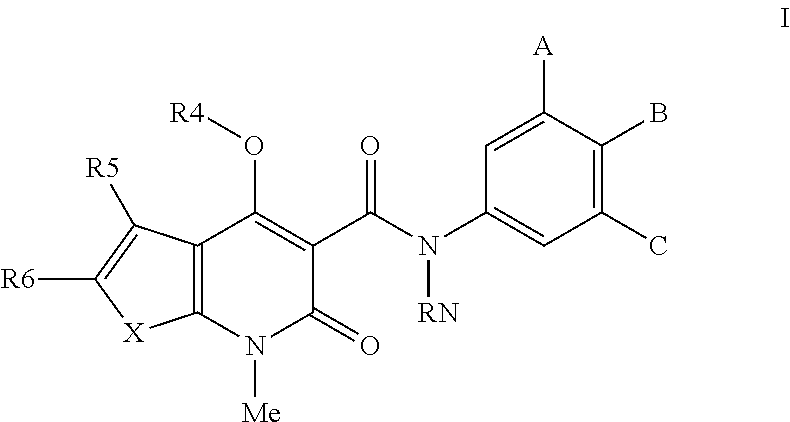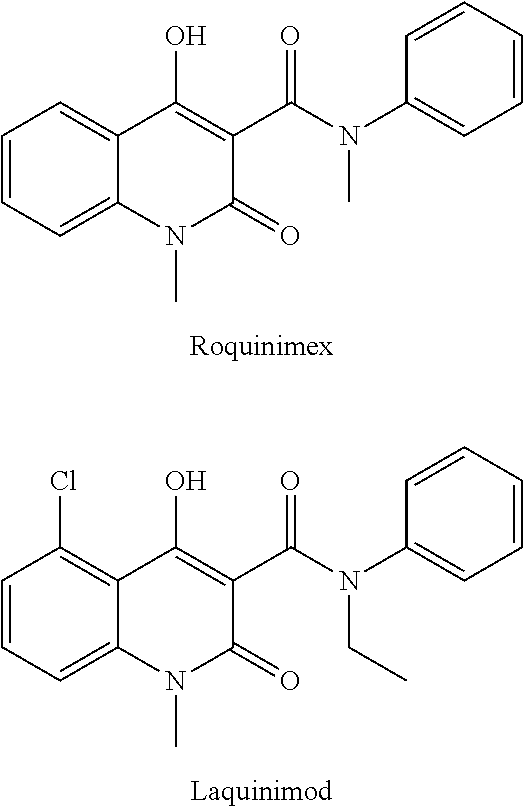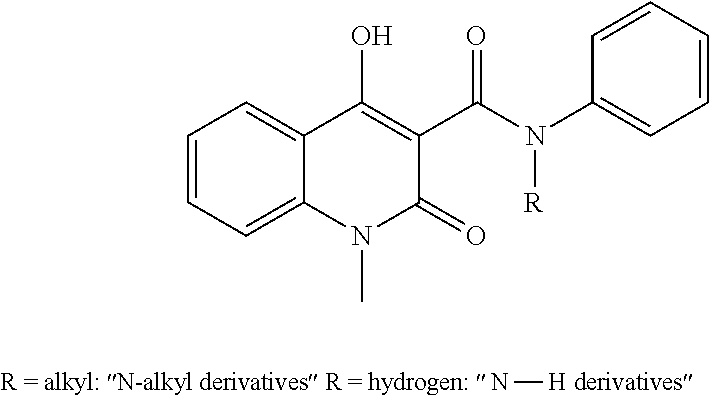1,2-dihydro-4-hydroxy-2-oxo-quinoline-3-carboxanilides as ahr activators
a technology of ahr activator and dihydro-4-hydroxy, which is applied in the direction of antibacterial agents, immunological disorders, metabolism disorders, etc., can solve the problems of inadequate exposure and inability to optimally treat topical treatment of prodrugs that are transformed by hepatic metabolism, and achieve low aqueous solubility, modulation of the metabolic stability of compounds, and easy to absorb
- Summary
- Abstract
- Description
- Claims
- Application Information
AI Technical Summary
Benefits of technology
Problems solved by technology
Method used
Image
Examples
example 1
N-(4-fluorophenyl)-1,2-dihydro-4-hydroxy-1-methyl-2-oxo-quinoline-3-carboxamide
[0361]
[0362]A solution of N-methyl-N-phenyl-1,2-dihydro-4-hydroxy-1-methyl-2-oxo-quinoline-3-carboxamide (15 mg, 0.050 mmol) and 4-fluoro-aniline (0.100 mmol) in toluene (0.5 mL) was stirred at 100° C. for 1 h. Heptane (1.5 mL) was added and the solution was allowed to cool to room temperature. The crystallized product was separated from the solution and washed with heptane to give the title compound (12 mg, 79%).
[0363]1H NMR: 3.74 (s, 3H), 7.07 (t, 2H), 7.34 (t, 1H), 7.40 (d, 1H), 7.65 (m, 2H), 7.73 (ddd, 1H), 8.26 (dd, 1H), 12.52 (s, 1H), 16.62 (s, 1H).
[0364]The following compounds were prepared by the same method in 70-95% yields:
example 2
N-(4-trifluoromethylphenyl)-1,2-dihydro-4-hydroxy-1-methyl-2-oxo-quinoline-3-carboxamide
[0365]
[0366]1H NMR: 3.74 (s, 3H), 7.33 (t, 1H), 7.41 (d, 1H), 7.62 (d, 2H), 7.73 (ddd, 1H), 7.82 (d, 2H), 8.26 (dd, 1H), 12.81 (s, 1H), 16.35 (s, 1H).
example 3
N-(4-ethylphenyl)-1,2-dihydro-4-hydroxy-1-methyl-2-oxo-quinoline-3-carboxamide
[0367]
[0368]1H NMR: 1.24 (t, 3H), 2.65 (q, 2H), 3.74 (s, 3H), 7.22 (d, 2H), 7.34 (t, 1H), 7.40 (d, 1H), 7.60 (d, 2H), 7.72 (ddd, 1H), 8.26 (dd, 1H), 12.44 (s, 1H), 16.87 (s, 1H).
PUM
 Login to View More
Login to View More Abstract
Description
Claims
Application Information
 Login to View More
Login to View More - R&D
- Intellectual Property
- Life Sciences
- Materials
- Tech Scout
- Unparalleled Data Quality
- Higher Quality Content
- 60% Fewer Hallucinations
Browse by: Latest US Patents, China's latest patents, Technical Efficacy Thesaurus, Application Domain, Technology Topic, Popular Technical Reports.
© 2025 PatSnap. All rights reserved.Legal|Privacy policy|Modern Slavery Act Transparency Statement|Sitemap|About US| Contact US: help@patsnap.com



